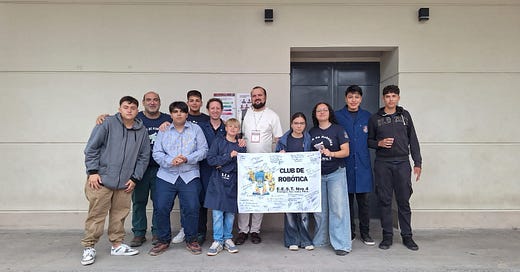Exploring Innovation at the IAA Latin American Conference for Small Satellites (IAALACSS-2024)
The IAA Latin American Conference for Small Satellites revealed the incredible momentum of the region’s space sector, blending innovation, collaboration, and a passion for small satellite technology.
Issue 104. Subscribers 26 000.
Two weeks ago, you may have read Alex’s post about her trip to the International Astronautical Congress (IAC) in Milan, which is organized each year jointly by the International Academy of Astronautics (IAA) and the International Astronautical Federation (IAF). Did you know that, in addition to IAC, the IAA organizes several smaller, regional or topic-focused events? The Latin American Conference for Small Satellites (IAALACSS) is one of these, and this time, it was hosted in Salta, Argentina. Previous editions have been held in various locations, primarily in Argentina and Brazil. Last week, I was lucky enough to attend this event.
(By the way, here is also the list of SpaceTech conferences in 2024-2025).

The conference attracted attendees from across Latin America, including representatives from Argentina, Brazil, Paraguay, and Peru. However, while I expected a strong regional focus, it became clear that this conference was truly international. I was thrilled to hear from speakers representing NASA, ESA, UNISEC, Spain, Italy, Germany, France, Japan, and the UK.
As the name suggests, the conference centers around small satellites. This focus makes a lot of sense for Latin America, where many countries are still emerging in the spacetech. Small satellites, or "smallsats," provide a natural starting point to gain experience and train young professionals in satellite engineering. But in Latin America, they don’t make it from scratch. Argentina and Brazil are two regional leaders in space exploration. Since SAC-A launch during the STS-88 Space Shuttle Endeavour mission in 1998, Argentina’s focus has been on Earth observation and scientific research, supported by the National Commission on Space Activities (CONAE) satellite programs. Brazil, managed by the Brazilian Space Agency (Agência Espacial Brasileira - AEB), has developed numerous satellite capabilities for data collection and environmental monitoring. Both countries continue to work on achieving self-sufficient launch capabilities (Tronador-II, VSB, VLM). During the conference, both countries have shown commitment to leveraging local and international partnerships to grow their influence in the space industry together with DLR, TU Berlin, and Kyushu Institute of Technology (Japan).
In the space industry, technical skills are only one part of the equation. Soft skills and teamwork are equally essential. Concurrent Design Facilities (CDF) and Agile Methodologies were popular topics at the conference, with a whole day dedicated to a captivating CDF demonstration led by Massimo Bandecchi, one of the keynote speakers.

Education was a central theme of the conference. The presence of so many young people was inspiring, and an entire session was focused on education and student projects. One full day showcased a robotics competition. I was fascinated to learn that, besides the well-known cubesats, many groups in the region are also exploring non-orbital designs like flatsats (satellites on a circuit board), cansats (satellites in a soda can), and other tiny platforms for education and student competitions. While some projects might seem like reinventing the wheel, it’s crucial to remember that these initiatives provide essential hands-on experience. The region sees the immense potential of the new space era, especially with launch costs going down. With the tremendous talent I saw, there is every reason to believe that many of these university labs and robotics clubs will soon transform into startups. To support this growth, speakers emphasized the importance of startup incubation. Yanina Hallak, presented an inspiring example of an incubation system that supports early-stage companies in aerospace in the Spanish region of Galicia.

The conference also delved into critical topics of remote sensing, robotics, space debris, and space law. Remote sensing is a key topic in Latin America, as it can help monitor and forecast natural disasters like heavy rains, floods, landslides, and forest fires—events that are, unfortunately, becoming more frequent due to climate change.
Space debris is another pressing issue, especially for small satellites. Fitting even the smallest low-thrust propulsion systems onto smallsats presents a real challenge. Weight and power are major limitations. Still, it was encouraging to see that the industry here is aware of these challenges. Regional players understand that satellite operators will soon need to take responsibility for deorbiting their satellites. I learned about advancements in low-thrust propulsion systems in Latin America, and I was thrilled to hear that an Argentine company manufacturing solar panels, Solartec, is already competing globally. Space law, too, is becoming intertwined with space debris and situational awareness, as the current space treaties did not account well for today’s sustainability issues. But now, successfully addressing space debris, probably, will be the first issue effectively solved by international cooperation in the legal field. This could even provide a framework for managing other issues, such as in-situ resource utilization and peaceful space.
On the final day, we were treated to visit the QUBIC and LLAMA telescopes high up in the Andes near the Argentina-Chile border. These two instruments benefit from the area’s dry climate and high altitude (4,825 meters), where low humidity allows for the observation of very short wavelengths—less than 1 millimeter. It was an unforgettable experience, witnessing the beauty of the landscape and the dedication of scientists working in such extreme conditions. I am deeply grateful to the conference organizers for this incredible opportunity.
Throughout the conference, the atmosphere was warm and welcoming, and I felt the hospitality of the organizers and the region. Informal talks, dinners, and even songs brought us all closer. By the end, I wasn’t just filled with new knowledge and insights; I felt like I had become part of a family of space enthusiasts. This was truly an inspiring experience that I’m excited to share with all of you! We at Space Ambition also hope to meet you at one of the upcoming SpaceTech conferences next year!






